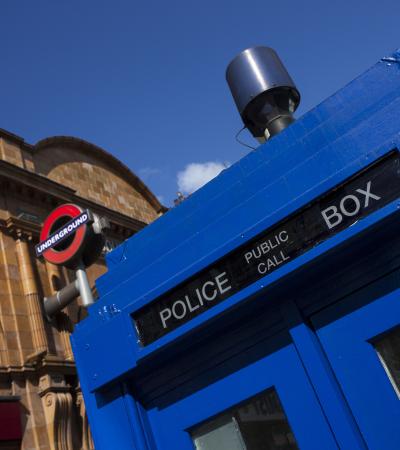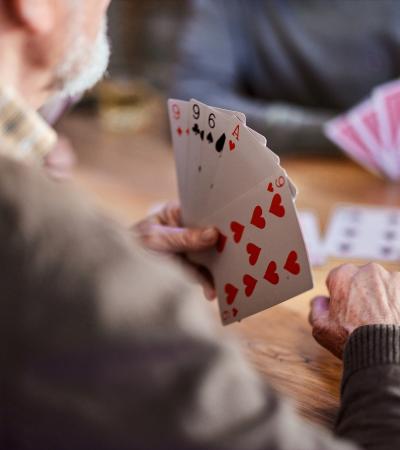Faculty vs. Student Trivia Night is a trivia contest in which students teams compete against teams of professors. Each game has multiple rounds, and each round has a different topic or type of challenge (like identifying songs from sound clips or answering different types of questions from subjects, such as history or science).
Every round, teams are given a set of 10 questions; they discuss the answer in their group before turning in their answer sheet to be scored. The last round is like the final "Jeopardy!" round, with teams bidding points that they earn or lose depending on if they answer correctly. The team with the most points wins.
The program seeks to support the university’s mission to foster community among students and faculty while giving librarians a chance to build relationships with faculty and students in a casual setting.
Advanced Planning
The first trivia night required about a month of preparation because I was emailing professors, researching trivia kits, designing an advertising plan, compiling trivia questions and printing materials. For subsequent trivia nights, if I am able to work uninterrupted, preparing the questions, sound clips, answer keys and handouts takes only one day.
To prepare, I purchase trivia packets and look at the categories for the rounds. Sometime I mix and match categories from different quizzes, and I usually need to update pop culture rounds. The music round requires the most work. In the past, I created a YouTube playlist, chose a 10-second clip, wrote down the exact start time for each clip, and then, on quiz day, I manually drag the cursor to that start point for each song. The manual method is doable, but everyone has to wait while you queue up the clip, plus on every third song or so you’re delayed by a YouTube commercial. Now I record the 10-second sound clips, edit them together and upload one sound file to Google Docs; on trivia night all I need to do is press "play."
Marketing
Promotion for the initial trivia event was two-pronged: promotion to professors and to students. The students had voted for Professors versus Student Trivia Night in a survey conducted at another event so I initially focused on advertising to professors. After library liaisons identified faculty who were likely candidates to participate, I sent an introductory email to them explaining the event and asking if they wanted to play. Once I had few professors committed to attending, I promoted the event to students using many of the same modes we use to promotion other events with additional help from professors. I emailed the faculty a PowerPoint slide of the flyer information so they could promote trivia night to their students.
Currently, I rely on minimal flyers and primarily depend on word of mouth from past attendees. I have an email listserv for students and professors who want news about trivia nights and they usually spread the word by inviting friends and co-workers. I send emails and post flyers a week before the event.
Budgeting
I purchase trivia packets from QuizRunners (formally Trivia Night in a Box). The quizzes download instantly, and the staff has always been very helpful by quickly answering questions and providing hosting tips. A single quiz is about $20, and you can obtain additional savings by purchasing several sets of trivia packets.
I didn’t need to purchase AV equipment because the university has microphones and speakers we can borrow for free. For the music identification round I create a YouTube playlist and use Camtasia (screen capture software) to record and edit sound clips that I upload to Google Docs. Camtasia isn’t free, but my library already owned the software so creating sound clips cost me nothing; if you don’t have Camtasia you can use free sound editing programs.
Day-of-event Activity
Having at least one co-host relieves stress. He or she can help you score answer sheets, double-check your math, run off more copies, research contested questions, etc.
Set-up is quick. I print copies of the questions and answers for the hosts; blank answer sheets for teams to write their answers on; and a chart for recording team names and tallying scores. Lastly, I connect the AV equipment (mic, speakers and laptop) and queue the sound clips.
Program Execution
Because the event is new, attendance is still growing. An average, 10 to 15 people (two to three teams) play. Attendees are passionate; everyone who participates thoroughly enjoys themselves and asks, “When’s the next one?” We now have a small group of regulars who help promote the trivia nights and let us know if they can’t attend. As long as people have fun and are still interested, we’ll continue hosting trivia nights.
Advice
I recommend buying a commercially designed quiz, at least for the first few trivia nights, because it’s easier to modify an existing trivia packet than creating one from scratch. Kits also include general rules and tips that introduce you to a standard format for running trivia events. As your confidence and experience increases, and if you have the time, you can begin creating your own trivia games.
Read through the trivia questions a few time,s because you may need help in pronouncing words; I had to ask a Russian-American co-worker how to pronounce “Holodets.”
We’re going to try switching from professors vs. students to a general trivia model where professors and students can be on the same teams so we don’t have to worry about attendance being even. Also, mixed teams will introduce a new element of camaraderie between faculty and students.
Supporting Materials
- Feedback (Coming Soon!)
- Programming Librarian Facebook Group


